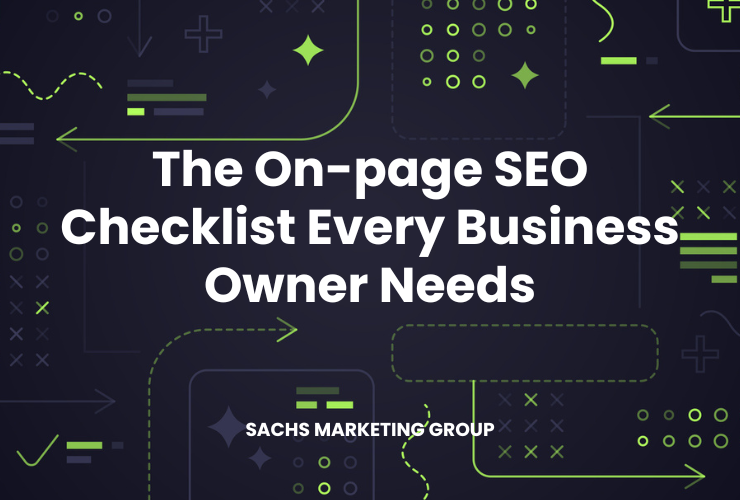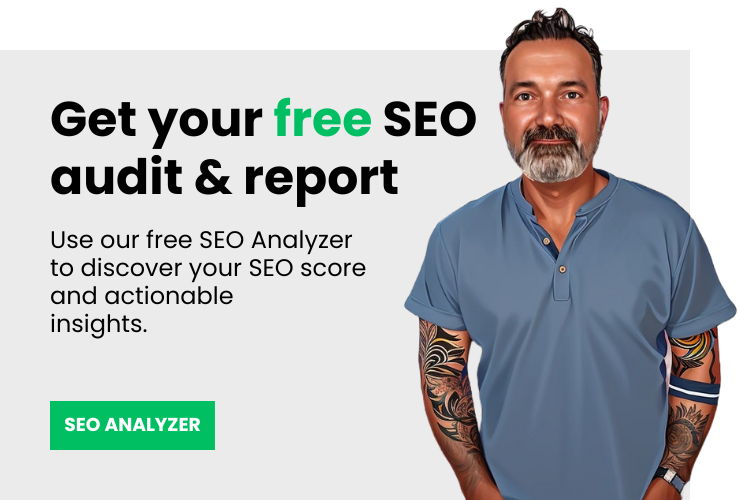Using an on-page SEO checklist provides a structured approach to enhancing your website’s visibility and ranking on search engines. It offers a systematic plan for optimizing individual page elements like keywords, title tags, meta descriptions, and content structure. Implementing this checklist ensures your website meets search engine guidelines and delivers an engaging, high-quality user experience, crucial for increased traffic and conversions.
Do you feel overwhelmed by trying to rank higher on search engines and attract more traffic to your website?
An on-page SEO checklist is a perfect solution to this problem, as it provides a structured and effective approach to optimizing each of your web pages.
By following this checklist, you’ll alleviate the stress of search engine optimization and start seeing improved website visibility and organic traffic.
In this article, we’re sharing an on-page SEO checklist to help you get started.
Overview
What is On-page SEO?
On-page SEO refers to the strategies implemented directly on your website to improve its visibility and ranking on search engines. These strategies involve optimizing the content and HTML source code of your website pages to make them more attractive and understandable to search engines and users alike.
Related: 10 Benefits of Ongoing SEO Services
Using an On-page SEO Checklist
An on-page SEO checklist is a strategic guide to optimizing individual web pages to rank higher in search results and attract more traffic. It’s crucial for business owners as it impacts directly on the visibility and user experience of their website, potentially driving more leads and sales.
The on-page SEO checklist includes factors like keywords, meta descriptions, title tags, URL structure, and more, all contributing to the page’s overall SEO strength.
1. Identify Your Target Keywords
The practice of identifying your target keywords is akin to tapping into your audience’s minds, understanding what they’re searching for, and how they express their needs online. Keyword research is fundamental in SEO, not only for driving targeted traffic but also for uncovering your audience’s interests. It helps you focus your content on topics that are valuable to your audience, thereby improving your chances of ranking well on SERPs.
For instance, if you’re an e-commerce store specializing in eco-friendly products, keywords like “sustainable clothing”, “eco-friendly home products”, or “organic personal care” could be on your list. A well-researched list of target keywords should cover a variety of search intents, including informational, navigational, and transactional.
Using keyword research tools can help you find the best keywords for SEO. Try using tools like Google’s free Keyword Planner, Semrush, or Ahrefs to streamline the process of keyword discovery. These tools reveal search volume data, keyword difficulty scores, and other relevant metrics to help identify the best keywords for your business.
2. Optimize the Title Tag
The title tag is a significant SEO element that serves as a concise summary of your webpage’s content. It appears in two crucial places: the SERPs and the web browser tab. An optimized title tag can positively impact click-through rates (CTR) from the search results and influence your page’s overall SEO performance.
Remember to keep your title tag within 60 characters to ensure it’s fully visible in search results. It should be engaging, compelling, and accurately represent the page’s content. Use distinct title tags for each page to avoid duplication.
Note: Google may change your title tag as it appears in their index if it feels it doesn’t accurately reflect your content. If you notice this, take note and revisit your content or title and make adjustments.
3. Use an H1 tag for On-page Title
The H1 tag is the HTML tag used for the main title of a webpage. It’s often the first content element users see upon landing on a page. Similar to how a book title provides the main topic of a book, an H1 tag gives users and search engines an overview of the page’s content.
Consider the H1 tag as the on-page equivalent of the title tag. It should be descriptive, engaging, and incorporate your target keyword. For instance, if you’re writing a blog post about home gardening, an effective H1 tag could be “Ultimate Guide to Successful Home Gardening”.
Although there are no strict length limits for H1 tags, it’s best to keep them concise and to the point. Remember, the H1 is different from the page’s title tag, and it’s okay if they aren’t identical. As a best practice, use only one H1 tag per page to avoid confusing search engines.
4. Write a Meta Description that Attracts Clicks
A meta description is a brief summary of your page that appears under the title tag in SERPs. It’s your chance to convince searchers that your page is exactly what they’re looking for. Make sure to include your target keyword, keep it within 150-160 characters, and write it in a way that incentivizes users to click.
For example, if you’re a photography studio in Los Angeles, your meta description could be: “Capture life’s special moments with [Your Studio’s Name], a top-rated photography studio in Los Angeles. Specializing in portraits, events, and commercial shoots.”
5. Optimize the URL Slug
The URL slug is the part of your URL that follows the domain name and should describe the content of your page. It should be easy to read, include your target keyword, and use hyphens (-) to separate words for readability.
For instance, if you’re a Los Angeles-based real estate agency creating a page about bungalows for sale, an optimized URL could be: example.com/los-angeles-bungalows-for-sale.
6. Mention Target Keywords Naturally
Using your target keywords in your content helps search engines understand what your page is about. However, it’s crucial to mention them naturally and avoid keyword stuffing, which can lead to penalties. The content should flow well, and the keyword usage shouldn’t feel forced.
For a yoga studio in Los Angeles: “Experience the tranquility and revitalizing effects of yoga at our Los Angeles studio. We offer a variety of yoga classes suitable for all skill levels.”
For a seafood restaurant in Los Angeles: “Visit our restaurant in the heart of Los Angeles for the freshest, most flavorful seafood dishes prepared by top-rated chefs.”
In both cases, the keyword “Los Angeles” is included naturally in the content.
7. Enhance the Quality of Your Content
Quality content is one of the cornerstones of effective on-page SEO. It should provide valuable, in-depth information that meets the needs of your audience. Moreover, it should be well-structured, easy to read, and free from grammatical errors. A good practice is to aim for a mix of content types, like how-to guides, listicles, or industry insights.
For instance, a Los Angeles fashion retailer could create comprehensive style guides, profiles of local fashion influencers, or articles on the latest fashion trends from LA’s fashion week.
8. Use Headings to Provide Clarity
In the early 2000s, headings were used by Google as an actual ranking factor. This sparked the common practice of including keywords within heading tags, like H2s and H3s, as a way to optimize content and increase rankings.
However, according to John Mueller, Google hasn’t used headings as a ranking factor for over a decade. Instead, he suggested Google views headings similar to how people view them – for clarity.
We do use headings when it comes to search. But we use them to better understand the content on the pages.
Using headings properly in your content not only improves readability but also helps search engines understand the structure of your page.
While heading tags may not hold power like they used to in the past, it’s still common to use H2 headings for the main subsections of your content, underlining the primary topics you’ll cover.
Similarly, subsequent H3, H4, etc., are used for nested subtopics within those sections, creating a clear content hierarchy that helps both readers and search engine bots navigate and comprehend your content more effectively.
9. Use Internal Links Strategically
Strategic use of internal links can help guide visitors through your website and enhance SEO by spreading “link juice” around your pages.
Aim to create a network of internal links that funnel users towards high-value pages, including important product or service pages, or cornerstone content.
Always ensure the anchor text used for the link is relevant to the page it points to, this not only aids user navigation but also gives search engines a clear idea of the page’s content.
10. Include Visuals
Incorporating visuals into your content strategy is a powerful way to improve user engagement, enhance comprehension, and increase dwell time.
Visuals can include images, infographics, diagrams, charts, videos, or any other type of visual content that helps illustrate your points. Always remember to optimize your images by compressing them for web use, using descriptive file names, and including relevant alt text for search engines.
For example, a restaurant could include visually appealing photos of their dishes, an infographic on the sourcing of their ingredients, or a video tour of their dining area to draw visitors in and improve their on-page SEO.
11. Add Schema Markup
Schema markup, also known as structured data, is a form of microdata that you can add to your website’s HTML to create enhanced descriptions, or “rich snippets,” which appear in search results.
This additional information helps search engines better understand your content and provides users with more information about your webpage.
There are different types of schema markups including those for articles, products, local businesses, and more. Implementing schema markup can make your pages stand out in SERPs, potentially increasing click-through rates and driving more traffic to your site.
Get a Free On-page SEO Audit
Looking for a free resource that will provide a detailed overview of your on-page SEO along with an easy-to-understand SEO score?
Our free on-page SEO audit dives deep into your website, revealing critical areas that need improvement. It scrutinizes your metadata, keyword usage, content quality, and so much more.
On-page SEO Checklist FAQs
Here are a few frequently asked questions about on-page SEO.
What is on-page SEO in simple words?
On-page SEO refers to the optimization practices applied directly to a webpage with the goal of improving its position in search engine rankings. This includes techniques like keyword optimization in the title, URL, and content, proper usage of header tags, creating quality content, optimizing images, and ensuring a good user experience.
Why does on-page SEO matter?
On-page SEO is crucial because it helps search engines understand your website and its content, as well as identify whether it is relevant to a searcher’s query. It increases your website’s visibility, drives more traffic, and contributes significantly to a website’s ranking on search engine result pages (SERPs).
What are the five most important on-page SEO factors?
The five most important on-page SEO factors include: keyword optimization in the title tag and content, high-quality and engaging content, optimized images with alt tags, internal linking for improved navigation, and a well-crafted meta description to attract clicks from SERPs.
What is on-page SEO vs local SEO?
On-page SEO refers to optimization tactics done on your website to improve its visibility in search engines. It’s applicable to all types of websites. Local SEO, on the other hand, is a subset of on-page SEO that focuses on optimizing a business’s online presence to attract more customers from relevant local searches, usually involving geo-specific keywords and local business listings.
Need Help with Your On-page SEO?
Are you having trouble climbing the search engine rankings and capturing your audience’s attention online?
Imagine the benefits of achieving top rankings – increased visibility, traffic, and customer trust. Sachs Marketing Group, an industry-leading SEO agency, can make this your reality.
Our team, proficient in on-page SEO, is dedicated to optimizing your website and boosting its performance in search engine results. We offer personalized strategies based on your specific business needs and goals. With our expertise, we’ll help you outrank your competition and attract more quality leads. Don’t let your website be a needle in the haystack. Contact Sachs Marketing Group today, and together, we’ll elevate your online presence and drive your business growth.
Conclusion
Following this on-page SEO checklist, you can significantly improve the visibility and ranking of your website on search engines.
This, in turn, will drive more traffic to your site and potentially result in more conversions and revenue for your business. SEO isn’t a one-time task, though, but rather a continuous effort. Regularly monitoring and optimizing your website is key to maintaining and improving your rankings. Remember, a well-optimized website is your ticket to online visibility, audience growth, and business success.
2 Comments
Leave a Reply
Contact us today to get the conversation started!














Great checklist! “The On-Page SEO Checklist for Busy Business Owners” is a fantastic resource for those juggling multiple responsibilities. The clear, actionable steps make it easy to improve on-page SEO without feeling overwhelmed. Thanks for simplifying the process and providing such practical tips!
Thanks for reading and for the kind words!